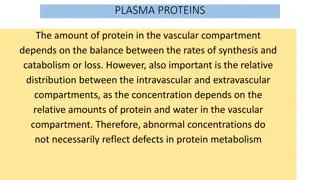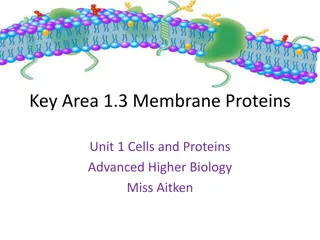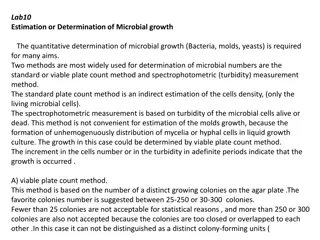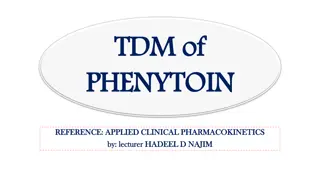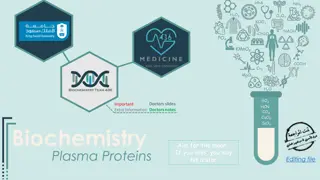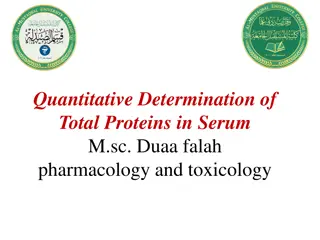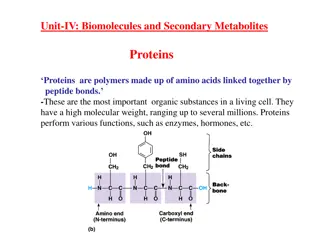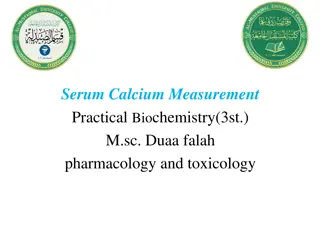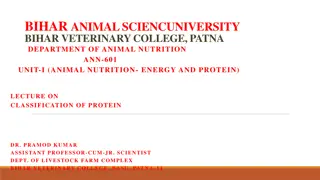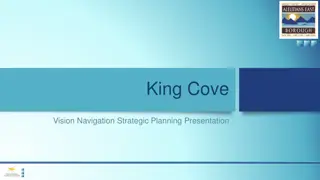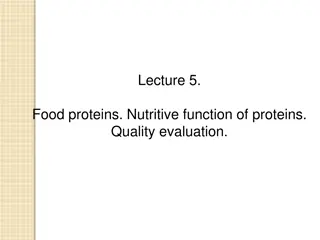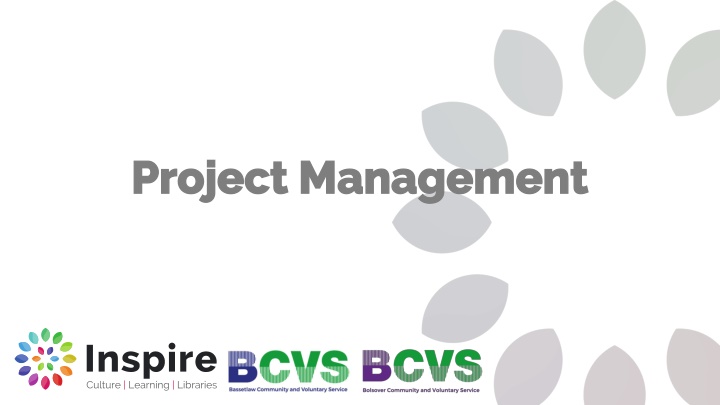
Quantitative Determination of Total Proteins in Serum: Importance and Methods
Proteins are crucial for body functions and health. This test measures protein levels in blood, specifically albumin and globulins. Serum total protein test is used for biochemical analysis, utilizing methods like biuret reagent, dye-binding, and refractometry. Normal values, indications, and test methodologies are discussed.
Uploaded on | 0 Views
Download Presentation

Please find below an Image/Link to download the presentation.
The content on the website is provided AS IS for your information and personal use only. It may not be sold, licensed, or shared on other websites without obtaining consent from the author. If you encounter any issues during the download, it is possible that the publisher has removed the file from their server.
You are allowed to download the files provided on this website for personal or commercial use, subject to the condition that they are used lawfully. All files are the property of their respective owners.
The content on the website is provided AS IS for your information and personal use only. It may not be sold, licensed, or shared on other websites without obtaining consent from the author.
E N D
Presentation Transcript
Project Management Project Management
Session 1 What is Project Management What is Project Management Ian Bond Introduction to Project Management
Project Management Project Management Session 1: What is Project Management? (IB) Session 2: Project Planning (MR) Session 3: Project Delivery (NR) Session 4: Recap and Assessment (IB)
Welcome to Project Welcome to Project Management Management Find a partner Tell your partner what your previous experience of projects has been (good, bad and ugly) When we come back together, you can share your experiences
What is a Project? What is a Project? What makes a project? How is this different from Business as Usual (BAU)?
What is a Project? What is a Project? A temporary thing with a defined start and end date It has a dedicated set of resources It has a life-cycle (more on this later) It delivers a unique product with a defined purpose BAU is: Standard day to day business that ensures continuity within the organisation. Monthly reporting, IT helpdesk, support for service users
What is a Project? What is a Project? Project Sponsor Project Manager Service Continuity Manager Project Delivery Team Stakeholders End Users/Beneficiaries
Different Project Management Different Project Management Tools and Approaches Tools and Approaches Many different types of Project Management approaches There is no 'right' approach. Need to fit the approach to the project Complex and sophisticated Project Management Can you name an example of an approach for these types of project? Efficiency projects focused on eliminating waste and maximising value Can you name an example of an approach? Smaller projects over a shorter time period Can you name an example of an approach?
Types of Organisations Types of Organisations And the role of the Project Manager And the role of the Project Manager Hierarchical/Functional Project Matrix How would you describe your organisation? What do you think may be the strengths and weaknesses of each approach? How do you think the project manager operates in each type of organisation?
Strengths and Weaknesses Strengths and Weaknesses Hierarchical/Functional: Strengths = People with technical skills in the department/functional area deliver the project that requires those skills. Weakness = Silo working Matrix: Strengths = Project is visible across the org + the management of resources is more efficient. Weakness = Dual reporting lines can cause confusion Project: Strength = clear focus on the project that's what the organisation is for. Weakness = When the project is completed there's no need to keep the team together and the organisational learning can be lost.
Why is it Better to have a Why is it Better to have a Systematic Approach? Systematic Approach? Projects have a relevant Business Case Projects follow a recognised project life cycle Projects have a structured methodology for the delivery of projects ensuring consistency of practice Clearly defined processes and documentation More effective decision making at key stages Reporting and escalation routes Effective quality management
Business Case Business Case Business Case and Strategy Who is involved in developing and producing the business case? Other business case contributors Typical business case content: background/situation; benefits; budget; risks; options appraisal; Additional Content
Importance of a Business Case Importance of a Business Case throughout the Project Lifecycle throughout the Project Lifecycle Concept Definition Deployment Transition
Project Life Cycles Project Life Cycles Benefits of the Project Life Cycle: Improved planning of work Clearer identification of priorities More effective risk management Greater estimating accuracy More representative performance management Greater adoption of continual improvement Improved control More effective stakeholder communication
Benefits of Conducting Reviews Benefits of Conducting Reviews Throughout the Life Cycle Throughout the Life Cycle Deliverables The business case Management processes Decision Gates Benefits Reviews Audit Other Reviews Stage Reviews Post-Project Reviews
Learning Summary Learning Summary Why are projects structured as phases in a linear life cycle? Explain the benefits of conducting reviews throughout the project life cycle (including decision gates, benefits reviews and audits)
Stakeholder Engagement Stakeholder Engagement Understand the role of various stakeholders Identifying the real nature of each stakeholder group's business and their consequent interest in the project Understanding their behaviour and motivation towards the project Assessing how they may react to various approaches and communication Identifying the characteristics of the stakeholders' environment and development appropriate responses to facilitate a good relationship
Stakeholder Engagement Stakeholder Engagement (contd.) (contd.) Responding to the stakeholder's motivation in relation to the project Determining the key areas that will have the most impact on the successful reception of the project
Importance of Managing Importance of Managing Stakeholders Expectations to the Stakeholders Expectations to the Success of the Project Success of the Project Enabling more effective risk assessment Improved communications planning Ensuring a productive team is formed Enabling effective engagement actions to be initiated Increased likelihood of project being accepted
Short Quiz Short Quiz What have you What have you Learned? Learned? 1 which of the following statements about the role of the project sponsor is false? A a project sponsor is an advocate for the project and the change it brings about. B a project sponsor writes and owns the project management plan. C a project sponsor is able to work across functional boundaries within an organisation. D a project sponsor is prepared to commit sufficient time and effort to support the project.
Short Quiz ( Short Quiz (Contd Contd) ) 2 which statement best describes a responsibility of the project sponsor? A monitoring progress and use of the project resources. B analysing the project team's productivity. C ensuring the benefits of the project are realised. D planning project evaluation reviews for lessons learned.
Short Quiz ( Short Quiz (Contd Contd) ) 3 what is the key role of the project manager? A coordinating the development of the project management plan. B conducting benefits realisation reviews. C reviewing progress against success criteria and checking that the planned business benefits will be achieved. D authorising any changes to the business case.
Short Quiz ( Short Quiz (Contd Contd) ) 4 The group whose remit is to set the strategic direction of a project is commonly known as: A the project management team. B primary users. C steering group. D suppliers.
Short Quiz ( Short Quiz (Contd Contd) ) 5 which stakeholders are likely to form the main part of a project steering group/board? A project sponsor, project manager and quality manager. B corporate management, project sponsor, quality manager, project office. C sponsor, supplier representative, user representative. D sponsor, project manager and senior project team members
Short Quiz ( Short Quiz (Contd Contd) ) 6 who in the project is responsible for benefits realisation? A the senior management of the organisation. B the project manager. C the sponsor. D the end users.
Short Quiz ( Short Quiz (Contd Contd) ) 7 which of the following roles is primarily responsible for defining goals and creating vision for the operability of the project's outputs? A project sponsor. B product owner. C user. D business case owner.
Short Quiz ( Short Quiz (Contd Contd) ) 8 when the majority of PMO functions are delivered under the control of the project/programme/portfolio manager, this could be described as a: A central PMO. B embedded PMO. C hub and spoke PMO. D matrix PMO.
Short Quiz ( Short Quiz (Contd Contd) ) 9 when effectively implemented, what is one of the key roles of governance? A provide confidence that the business case is the best option for the current circumstances and that there will be no changes as the project is being delivered. B provide confidence that the plans that have been developed will guarantee that the project will be delivered on time and to budget. C provide confidence to all stakeholders that projects are being well managed and the most appropriate financial and technical controls are being exerted. D provide confidence to all project team members that their jobs are secure at least from the period of the project start to the handover.
Short Quiz ( Short Quiz (Contd Contd) ) 10 governance cold best be described as: A the framework of authority and accountability that defines and controls the outputs, outcomes and benefits from projects, programmes and portfolios. B the framework that structures a review of the project and aids a decision to be made whether to continue with the next phase or stage of the project. C the framework that is used for selection, prioritisation and control of an organisation's projects and programmes in line with its strategic objectives and capacity to deliver. D the framework used by the organisation and approved by the project board at project initiation that allows the definition of the terms of reference for the project.
Conclusion Conclusion Project Vs BAU Different Project Management Approaches (e.g. Prince 2/Agile/Sprint etc.) Project Roles (Project Sponsor/Project Manager/Business as Usual) Different types of organisation (Functional/Hierarchical/Matrix/Project) Why be systematic when managing projects? Business Case Project Life Cycle / Reviews Stakeholder Engagement Stakeholder Management Quiz Next steps: Project Planning next week with Michael Thank You!!!
Session 2 Project Planning Project Planning Michael Reid
Project Planning Project Planning Schedule Management including GANTT Charts Critical Path Risk Quality Scope Procurement Change & control measures Cost Project controls Health & Safety Stakeholders & communication Information and reporting requirements Session 2
Schedule Management Schedule Management Session 2
Schedule Management Schedule Management Session 2
Session 2 Schedule Management Schedule Management Work Breakdown Structure (WBS)
Session 2 Schedule Management Schedule Management A completed work breakdown structure will help to develop the Gantt chart Have a go at completing a basic WBS for the design and delivery of a new course What is the Parent Task? What are the child tasks?
Session 3 Project Delivery Project Delivery Nicky Reed
Session 4 Recap and Assessment Recap and Assessment Ian Bond

